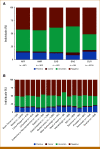Rate of Pathogenic Germline Variants in Patients With Lung Cancer
- PMID: 37992258
- PMCID: PMC10681406
- DOI: 10.1200/PO.23.00190
Rate of Pathogenic Germline Variants in Patients With Lung Cancer
Abstract
Purpose: Germline genetic testing (GGT) is now recommended for all patients diagnosed with ovarian or pancreatic cancer and for a large proportion of patients based solely on a diagnosis of colorectal or breast cancer. However, GGT is not yet recommended for all patients diagnosed with lung cancer (LC), primarily because of a lack of evidence that supports a significant frequency of identifying pathogenic germline variants (PGVs) in these patients. This study characterizes GGT results in a cohort of patients with LC.
Methods: We reviewed deidentified data for 7,788 patients with GGT (2015-2022). PGV frequencies were compared to a control cohort of unaffected individuals. GGT results were stratified by genomic ancestry, history of cancer, and PGV clinical actionability per current guidelines.
Results: Of all patients with LC, 14.9% (1,161/7,788) had PGVs. The rate was similar when restricted to patients with no cancer family history (FH) or personal history (PH) of other cancers (14.3%). PGVs were significantly enriched in BRCA2, ATM, CHEK2, BRCA1, and mismatch repair genes compared with controls. Patients of European (EUR) genomic ancestry had the highest PGV rate (18%) and variants of uncertain significance were significantly higher in patients of non-EUR genomic ancestry. Of the PGVs identified, 61.3% were in DNA damage repair (DDR) genes and 95% were clinically actionable.
Conclusion: This retrospective study shows a LC diagnosis identifies patients with a significant likelihood of having a cancer-predisposing PGV across genomic ancestries. Enrichment of PGVs in DDR genes suggests that these PGVs may contribute to LC cancer predisposition. The frequency of PGVs among patients with LC did not differ significantly according to FH or PH of other cancers.
Conflict of interest statement
The following represents disclosure information provided by authors of this manuscript. All relationships are considered compensated unless otherwise noted. Relationships are self-held unless noted. I = Immediate Family Member, Inst = My Institution. Relationships may not relate to the subject matter of this manuscript. For more information about ASCO's conflict of interest policy, please refer to
Open Payments is a public database containing information reported by companies about payments made to US-licensed physicians (
No other potential conflicts of interest were reported.
Figures



References
-
- Bougeard G Renaux-Petel M Flaman JM, et al. : Revisiting Li-Fraumeni syndrome from TP53 mutation carriers. J Clin Oncol 33:2345-2352, 2015 - PubMed
Publication types
MeSH terms
LinkOut - more resources
Full Text Sources
Medical
Research Materials
Miscellaneous

